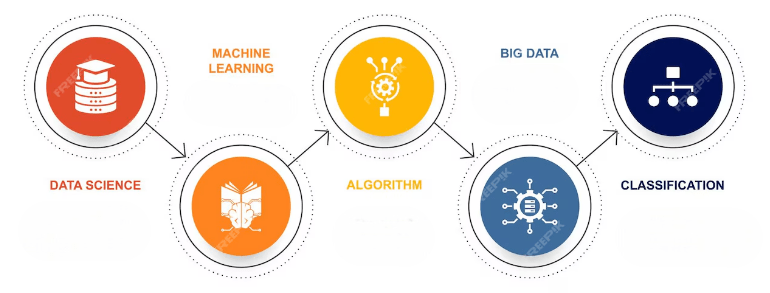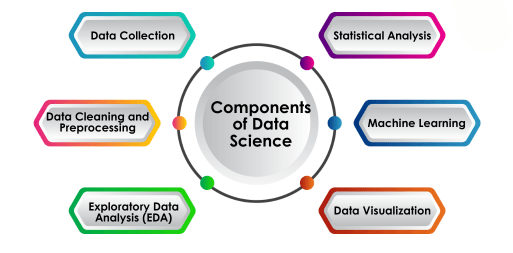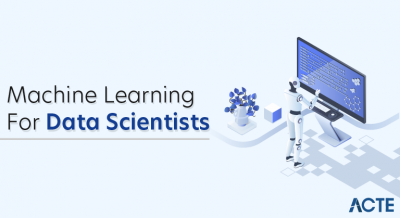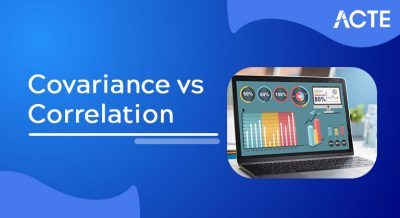
- Introduction to Data Science
- Why Learn Data Science from Scratch?
- Prerequisites: What You Need to Get Started
- Core Concepts in Data Science
- Step-by-Step Guide to Building a Data Science Project
- Tools and Technologies for Beginners
- Common Challenges and How to Overcome Them
- Conclusion
Introduction to Data Science
Data Science is an interdisciplinary field that blends statistical techniques, computer science, and domain-specific knowledge to extract meaningful insights from data. As the volume of data generated across industries continues to grow rapidly, the demand for professionals who can make sense of this information has surged. Data scientists use tools and techniques such as machine learning, data mining, and predictive analytics to analyze structured and unstructured data. Their goal is to identify patterns, trends, and correlations that can support decision-making and strategic planning. The data science process typically involves several stages, including data collection, cleaning, exploration, modeling, and interpretation, all of which are covered in Data Science Training. A strong foundation in mathematics, particularly statistics and linear algebra, is essential. Programming skills especially in languages like Python and R are also crucial for handling data and implementing algorithms. Data Science has broad applications in various sectors, including healthcare, finance, marketing, and technology. It helps companies optimize operations, improve customer experiences, and innovate products and services. Ethical considerations, such as data privacy and bias in algorithms, are also critical components of the field. In essence, data science empowers organizations to transform raw data into valuable knowledge, making it one of the most impactful and evolving domains in today’s digital age.
Do You Want to Learn More About Data Science? Get Info From Our Data Science Course Training Today!
Why Learn Data Science from Scratch?
Learning data science from scratch offers a solid foundation for understanding one of the most in-demand and impactful fields in today’s digital world. Starting from the basics allows learners to build a clear understanding of fundamental concepts such as statistics, data analysis, and programming. Python Generators support this gradual approach, helping in mastering complex topics like machine learning, data visualization, and predictive modeling with confidence. By learning from the ground up, individuals can avoid gaps in knowledge that might hinder problem-solving and decision-making in real-world scenarios. Moreover, starting from scratch ensures a deep comprehension of how data science tools and techniques work behind the scenes, rather than relying solely on automated systems. It encourages critical thinking, creativity, and analytical reasoning skills that are essential for a successful data science career.

Beginners also develop strong coding skills in languages like Python or R, which are vital for data manipulation and algorithm development. Whether you’re a student, a professional switching careers, or simply curious about data, learning data science from the beginning opens up numerous opportunities. It equips you to tackle data challenges, make data-driven decisions, and contribute to innovation in any field, from healthcare and business to technology and beyond.
Prerequisites: What You Need to Get Started
- Basic Mathematics: Understanding foundational math concepts such as algebra, statistics, probability, and linear algebra is crucial for grasping data science techniques and algorithms.
- Programming Skills: Familiarity with at least one programming language, especially Python or R, is necessary to manipulate data, perform analyses, and build models.
- Understanding of Databases and SQL: Knowing how to use SQL to query and manage data stored in relational databases helps you access real-world datasets efficiently.
- Data Wrangling and Cleaning: Python vs R vs SAS Skills to preprocess and clean data, including handling missing values and formatting data correctly, ensure high-quality input for analysis.
- Basic Knowledge of Machine Learning: Familiarity with common machine learning concepts like supervised vs. unsupervised learning and basic algorithms prepares you for model building.
- Data Visualization: Knowing how to create visual representations of data using tools like Matplotlib, Seaborn, or Tableau is important for interpreting and communicating insights.
- Curiosity and Problem-Solving Mindset: A curious attitude and analytical thinking drive continuous learning, experimentation, and the ability to tackle complex data challenges effectively.
- Data Collection: Gathering data from various sources like databases, APIs, web scraping, or sensors is the first step. Good data collection ensures that you have relevant and quality information for analysis.
- Data Cleaning and Preprocessing: Raw data is often messy. Cleaning involves handling missing values, removing duplicates, and correcting errors to prepare data for analysis.
- Exploratory Data Analysis (EDA): Data Science Training includes EDA, which involves using statistics and visualizations to understand the structure, patterns, and relationships within the data. It helps identify key variables and insights.
- Statistics: Core statistical concepts such as mean, median, variance, probability distributions, hypothesis testing, and correlation are essential to making sense of data and drawing valid conclusions.
- Machine Learning: This involves creating algorithms that can learn from data and make predictions or decisions without explicit programming for each task.
- Data Visualization: Presenting data visually through charts, graphs, and dashboards makes complex data easier to understand and communicate to others.
- Model Evaluation and Validation: Assessing how well your model performs on unseen data using metrics like accuracy, precision, recall, and RMSE ensures your solutions are reliable and generalizable.
- Python: A beginner-friendly and powerful programming language widely used in data science for its simplicity and rich ecosystem of libraries.
- Jupyter Notebooks: An interactive coding environment that allows users to write code, visualize results, and add explanations in a single, shareable document.
- Pandas and NumPy: Core Python libraries for data manipulation and numerical computations. Pandas is excellent for handling structured data, while NumPy is key for performing fast mathematical operations.
- Matplotlib and Seaborn: Top Python Libraries For Data Science include visualization libraries that help you create charts, graphs, and plots to understand trends and patterns in your data effectively.
- SQL: A fundamental language for querying and managing relational databases. Learning SQL helps you extract and prepare real-world data for analysis.
- Google Colab: A cloud-based tool that lets you run Python code in a Jupyter-style notebook with free access to GPUs, perfect for learners without local setup.
- Scikit-learn: A user-friendly Python library offering simple and efficient tools for machine learning, including classification, regression, and clustering algorithms.
Would You Like to Know More About Data Science? Sign Up For Our Data Science Course Training Now!
Core Concepts in Data Science

Step-by-Step Guide to Building a Data Science Project
Building a data science project involves a structured process that transforms raw data into actionable insights. The first step is defining the problem clearly, understanding the business or research objective ensures that the project stays focused and relevant. Next is data collection, where data is gathered from various sources such as databases, APIs, or web scraping. Once collected, data cleaning and preprocessing are essential to handle missing values, remove duplicates, and format the data correctly. What is Logistic Regression? Following this, exploratory data analysis (EDA) helps in uncovering patterns, trends, and relationships using statistics and visualizations. This step often guides the selection of relevant features for the model. Then comes model building, where suitable algorithms are chosen (e.g., regression, classification, clustering) and trained using the processed data. After training, the model is evaluated using metrics like accuracy, precision, or RMSE, depending on the task. Once the model performs satisfactorily, it is deployed into a real-world environment or integrated into an application. Finally, the project enters the monitoring and maintenance phase, ensuring the model stays accurate over time. This end-to-end approach not only enhances technical skills but also provides practical experience in solving real-world data problems.
Gain Your Master’s Certification in Data Science by Enrolling in Our Data Science Masters Course.
Tools and Technologies for Beginners
Common Challenges and How to Overcome Them
Data science projects often come with a variety of challenges that can affect progress and outcomes. One of the most common issues is poor-quality data, including missing, inconsistent, or noisy data. To overcome this, data cleaning techniques and robust validation processes are essential. Another major challenge is insufficient data, which can hinder model performance. In such cases, techniques like data augmentation or synthetic data generation can be helpful. Choosing the right algorithm is another hurdle. With so many models available, selecting the most suitable one requires experimentation and a solid understanding of the problem. Why Data Science Matters & How It Powers Business Value Cross-validation and model comparison can guide this decision. Additionally, lack of domain knowledge can lead to misinterpreting data or building irrelevant models. Collaborating with domain experts ensures the project remains accurate and valuable. Overfitting and underfitting are technical challenges that can compromise model generalization. Regularization techniques, proper feature selection, and tuning model parameters help mitigate these issues. Lastly, communication gaps between technical teams and stakeholders can create misunderstandings. Clear visualizations and storytelling with data improve communication and decision-making. Overcoming these challenges requires a mix of technical skills, collaboration, and strategic thinking to deliver successful data science outcomes.
Want to Learn About Data Science? Explore Our Data Science Interview Questions & Answer Featuring the Most Frequently Asked Questions in Job Interviews.
Conclusion
Learning data science from scratch is both a challenging and rewarding journey. While the path may seem steep at first, starting with the fundamentals lays the groundwork for long-term success. By building a strong understanding of key concepts such as statistics, programming, and data analysis you gain the tools needed to tackle real-world data problems confidently. Whether your goal is to switch careers, enhance your current role, or explore a new passion, Data Science Training offers limitless opportunities for growth and impact. Hands-on practice is essential. Working with datasets, building simple models, and visualizing results not only deepens your skills but also helps you see the practical value of what you’re learning. Pairing this with a curious mindset allows you to stay motivated, ask the right questions, and continuously improve. The field is vast, but every expert data scientist started exactly where you are now at the beginning. So embrace the process. Learn one concept at a time, write one line of code, analyze one dataset, and uncover one insight. With persistence and passion, your journey into data science can become a transformative and fulfilling experience.





